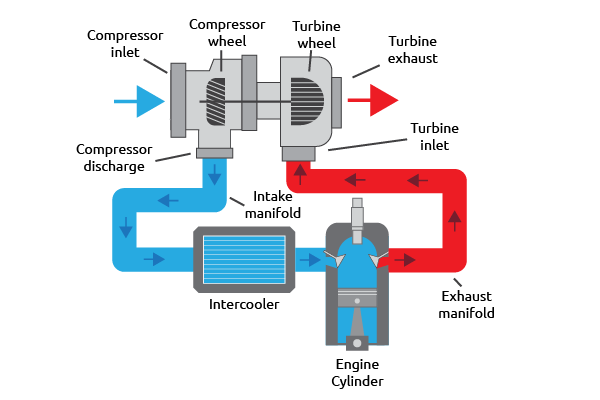Blog
What is Forced Induction?
Forced induction has built a reputation for being the ultimate addition to a vehicle when chasing significant power increases. Nowadays, forced induction can be found more and more in commuter vehicles since it can improve efficiency while retaining horsepower and torque.
But what exactly is forced induction? In this article, we’ll go over the benefits and drawbacks of forced induction systems, as well as why they took such a massive hold on the automotive industry.
What is Forced Induction?
When you get down to it, engines are air pumps. Combustion is achieved by igniting a mixture of air and fuel, and the energy from the combustion sends power to the wheels of your car. The more air and fuel that can be introduced to the combustion step, the more power can be made.
Adding more fuel is relatively easy. In modern cars, fuel pumps and injectors control the flow of fuel. Air flow into the engine is limited to the suction of the engine and ambient air pressure of the atmosphere. Engines without forced induction are considered naturally aspirated.
Forced induction allows more air to be “force” fed into the engine at a pressure greater than that of the atmosphere.
This means that the increased amount of air pushed into the motor will lead to more powerful combustion, and a considerable increase in horsepower. By squeezing more power out of combustion, small engines are able to run more efficiently while still making solid power numbers, and performance engines can dial up the power significantly.
At one point, forced induction was a technology limited to high-performance sports cars, racing applications, aviation, and heavy-line diesel trucks. While the majority of vehicles on the road are still naturally aspirated, more and more vehicles, from commuter cars to sport bikes, are embracing boost.
Types of Forced Induction
Forced induction is achieved with two main technologies; turbochargers and superchargers. While they accomplish the same thing, the ways these devices pressurize air is different.
Superchargers
As the original form of forced induction, superchargers saw their first adoption in aircraft and automobile engines in the 1920s and 30s. Racecars and warplanes were the only common use cases for forced induction for the first half of the 20th century, but as designs and development progressed, they eventually became a widely used method in consumer sports cars, luxury vehicles, and the American muscle scene.

The defining feature of superchargers is their belt-driven designs, meaning they are powered by the output of the engine itself. A drive belt runs off the engine, spinning the supercharger with it. Superchargers are engine-driven air compressors, using an impeller to create pressure and force large amounts of air into the motor. The faster the engine spins, the more pressurized the air becomes.
Since superchargers are driven by the engine, they create a very linear increase in boost pressure. Supercharged engines lack the “peaky” nature of turbochargers, which will be discussed later on in this article.
This is also one of the supercharger’s primary drawbacks. Since they rely on energy produced by the engine, superchargers are “parasitic”, meaning they leach power from the engine to create pressure. This means superchargers are significantly less efficient than their turbocharger counterparts.
Turbocharger
Similar to superchargers, turbochargers (commonly called turbos) first saw usage in aviation and even marine applications before making their way to consumer vehicles.
Turbos have become the most common form of forced induction in recent years. While they serve the same purpose as superchargers, the method in which they go about it is much different.
Turbocharging harnesses what would normally be spent exhaust gasses to spin a turbine to create pressure, as opposed to being belt-driven. As a result of this, turbochargers can produce a boost without the parasitic draw.

However, this reliance on exhaust gasses also leads to their biggest downside: turbo lag. The power delivery from a turbocharger is not immediate or linear, as the exhaust gasses first have to spool up the turbine. This sluggish feeling is commonly referred to as turbo lag.
The problem of turbo lag has been partially mitigated by advances in turbocharger designs, but the issue still remains one of the largest drawbacks of turbochargers.
Why Forced Induction?
While force induction started in the racing, industrial, and military applications, as we went over, it has gained popularity with automotive manufacturers over the years. Even new Volkswagen Jettas and Chevrolet Traxs make use of the tech that was once reserved for the most advanced vehicles of the time.
Turns out forced induction is useful for more than just making fast cars. While turbos don’t directly increase fuel economy, they do let manufacturers push more power out of small and efficient engines. Vehicles that once needed a V8 can now instead use a turbocharged 4- or 6-cylinder, meaning that SUVs and trucks can use them to increase fuel economy while maintaining or even increasing power figures.
Advancements in turbocharger designs have made them considerably more reliable and efficient than they previously were, making them practical in circumstances they might not have been 15 years ago.
Turbocharger vs. Supercharger: Which is Better?
Both main forms of forced induction have their benefits and drawbacks. Superchargers provide their power increases instantly, while turbos suffer from lag as the turbine spins up to full speed. However, turbochargers do win in efficiency, as they do not draw their power off of the engine itself.
Superchargers tend to be the more reliable of the two, as they’re generally simpler designs than turbos with fewer components to fail over time. With that said, turbochargers have come a long way in terms of reliability.
While neither is a bad option, turbochargers have largely won in popularity with manufacturers due to their fuel-efficient designs and non-parasitic nature. The question of which is right for you is entirely up to personal preference and the type of vehicle you’re purchasing.
Turbo & Supercharger Services at Alex’s Autohaus
If you own a vehicle with forced induction or are looking to have it installed on your vehicle, the performance experts at Alex’s Autohaus can take care of you! Our ASE-certified technicians have extensive experience inspecting, servicing, and repairing forced induction systems. Call or schedule an appointment on our website today.

Nationwide Warranty
3 YEAR, 36,000 MILE
Alex’s Autohaus offers all customers the Bosch and Tech-Net Peace of Mind Nationwide Warranty. The 36 month/36,000 mile warranty is honored at over 10,000 service centers across the country. Our 36,000 mile warranty is the best in the business!
Read More Schedule Now